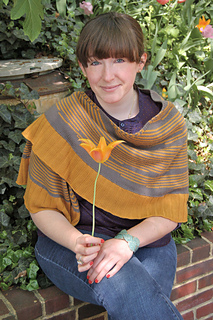patterns >  doviejay's Ravelry Shop and 1 more...
doviejay's Ravelry Shop and 1 more...
> Scratch That







Scratch That
Finished Measurements:
• 57” (145 cm) wingspan
• 20” (51 cm) depth at center back
Materials:
• 3 skeins MC, color Caviar
• 4 skeins CC, color Turmeric
(230 yards/50 grams) Knit Picks Capretta (80% Fine Merino Wool, 10% Cashmere, 10% Nylon)
Needles: size US 1.5 (2.5 mm) 60” (152.5 cm) circular needles
You may wish to use shorter circular needles for the starter tab and beginning rows
Extras:
• 8 stitch markers, labeled A, B, C, D, E, F, G, H
• blocking tools
• tapestry needle for weaving in ends
Gauge: 28 sts and 44 rows over 4”(10 cm) in stockinette stitch, post blocking
Notes
The first stitch of every row is slipped purlwise, with yarn in front.
When pattern calls for you to Work Plain, refer to the Definitions section and work a Plain Right Side or Wrong Side Row, as called for in the pattern. Right Side Rows are odd-numbered rows and vice versa.
This pattern uses short row wedges to create the broken stripes. Six short rows are followed by two plain rows that stretch all the way across. These groups of eight rows are all built up on one side of the shawl, then are balanced on the other side. The building up and balancing happens three times over the course of the shawl, making up the three sections.
Markers are used to track Short Row placement and are identified with letters of the alphabet. Short Rows are cheated to one side of the shawl and markers are not placed symmetrically.
When working a set of Starting or Ending Short Rows the non-working yarn is carried up the outside edge. The Contrast Color is broken at the end of each section and rejoined on the other edge of the work.
Short Rows are worked as for German Short Rows, without wraps. Yarn is brought tightly up and over the turned stitch, as described in the Short Row directions, which hikes the turned stitch up on the needle. When knitting past these stitches in subsequent rows, knit the original stitch together with the yarn brought hard up over the needle; they are treated as one stitch.
In order to preserve the garter edge in sections where the Ending Short Rows are being worked there are Alternate Plain Rows. The only difference is the left edge of the knitting.
5723 projects
stashed
5462 times
- First published: July 2013
- Page created: July 1, 2013
- Last updated: August 5, 2022 …
- visits in the last 24 hours
- visitors right now




